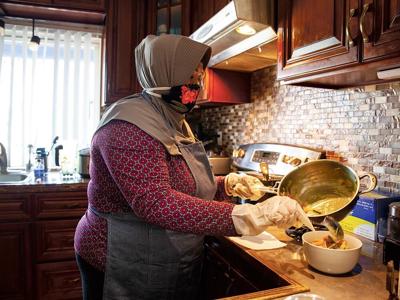“American food” implies a certain set of dishes that are American in origin. Except even things that are as “American as apple pie” come from different cultures, times and places. The first recorded apple pie recipe was found in the late 1300s in England. Hamburgers wouldn’t exist if the meat grinder hadn’t been invented in Germany, and if beef cattle weren’t introduced by the Spanish. In short, American food is complicated, as are its origin stories.
Tuty Sani, who was born in Padang, Indonesia, lived in Jakarta and is now in Marina, is writing the first chapter of her food story. After 26 years running day-care services at her home and Covid-19 effectively shutting down her operations, she and her sons, Alan and Adrian Sani, along with her daughter-in-law Katie Sani, turned to their kitchen and their culture.
“I have five kids, I was always cooking for them and for other people too – like personal catering,” Tuty says. “I was waiting and waiting [for day-care to reopen] and my kids asked me, why don’t you cook your food while you’re waiting?”
With their help, she took to Instagram as Tante Tuty’s Kitchen (@tantetutyskitchen). There, customers can pre-order from Thursday to Sunday. They receive a confirmation via email, with instructions for payment and a Wednesday pickup time.
The menus change from week to week, with à la carte options and nasi rames – a sort of bento-style combination of smaller dishes surrounding rice.
Like with many introductions to immigrant food, the family looked for ways of adapting the menu to American taste buds. Think orange chicken, a sticky sweet dish of deep fried chicken pieces served in North American Chinese restaurants and made famous in the late 1980s by Panda Express. Or Japanese teriyaki – what was once a light coating of a complex sauce of soy, mirin and other Japanese ingredients has become a thick sweet and salty glaze for grilled chicken and steak, by way of Hawaii.
But orange chicken walked so Tuty’s Indonesian Padang cooking – like gulai, rendang and terong tahu balado hijau – could run. “If you look around Marina, there is a Thai restaurant and at least two Vietnamese places,” Alan says. “I think people are ready for an Indonesian place.”
There are some similarities between all of those cuisines, like the use of coconut milk and aromatic elements like lemongrass, galangal and turmeric – all evolved with a similar need to preserve food in tropical climates, and come from old spice trade routes connecting Southeast Asia.
But Padang cuisine is almost always a low and slow process. Whereas many Thai curries can take minutes to whip up, beef rendang can use similar ingredients with an entirely different result because it’s braised in coconut milk for much longer than a lighter curry.
Tuty explains Padang cuisine relies on time, plus sharp chili flavor, kecap manis (dark sweet soy sauce), a base of sambal – a mixture of shallots, garlic, shrimp paste and chilies that varies from household to household – and of course, rice. Her dishes are specifically garlic heavy and made with halal meat.
Though they’re not committing to creating an entirely Americanized Indonesian dish, there are some things they compromise on. Like items with a lot of shrimp paste. “We try to keep that off the menu because it’s a taste many people aren’t used to,” Tuty says.
She also makes sure things aren’t so spicy. And the team runs its recipes by Katie, her white daughter-in-law who didn’t grow up with Padang food. “She’s our taste tester,” Tuty jokes.
Another compromise is the price. Though the cooking is labor-intensive and can take a full day’s work, the prices are in the $10-$15 range. “It’s like charging $18 for pad thai – it has to be really good,” Katie says.
Sani’s sons, who were both born and raised in the U.S and who used food as a way to connect back to their culture, think she’s selling herself short. “She’s definitely underselling,” Adrian says. “I guess [prices] would be a little different in a brick-and-mortar, but for now it’s been such a fun team effort teaching people about our culture.”
Follow TANTE TUTY’S KITCHEN and order from a weekly rotating menu at instagram.com/tantetutyskitchen.


(0) comments
Welcome to the discussion.
Log In
Keep it Clean. Please avoid obscene, vulgar, lewd, racist or sexually-oriented language.
PLEASE TURN OFF YOUR CAPS LOCK.
Don't Threaten. Threats of harming another person will not be tolerated.
Be Truthful. Don't knowingly lie about anyone or anything.
Be Nice. No racism, sexism or any sort of -ism that is degrading to another person.
Be Proactive. Use the 'Report' link on each comment to let us know of abusive posts.
Share with Us. We'd love to hear eyewitness accounts, the history behind an article.